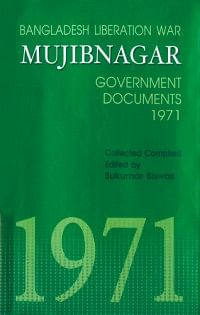Book Review
Oath-taking at Bidyanathtala
Zobaida Nasreen
Bangladesh Liberation War Mujibnagar Government Documents 1971; compiled and edited by Sukumar Biswas; Mowla Brothers; February 2005; Taka 1200; 655 pp.It is undoubtedly true that the Bangladesh War of Liberation is the most remarkable event in the history of the people of Bangladesh, and it is equally true that the documentation of this struggle is a continuous process. Unfortunately, since the history of the liberation war has become a highly politicized matter, its history, and interpretations of it, have become a contested site. Though the war in 1971 was itself the historical consequence of a long-lasting economic, political and social oppression, it is often treated as an outburst of the oppressed people. It was as a part and a continuation of this history that the Pakistani army launched a barbarous attack on civilians on the night of March 25, 1971. It was the beginning of a genocide with rare parallels in world history. After the declaration of independence by Sheikh Mujibur Rahman on 25th March, a provisional, independent government of Bangladesh was formally established on 10 th April, 1971. The oath-taking ceremony of this provisional government took place at Bidyanathtala under Meherpur sub-division of Kushtia district, which was subsequently renamed as Mujibnagar. From then on, this provisional Bangladesh government came to be popularly known as 'Mujibnagar Government'. Yet there is a scarcity of reliable documentation about the Mujibnagar Government, which played not only the pivotal role in our struggle for independence, but which is also considered as the first non-institutionalized government of the Bangladeshi people. The provisional government of Mujibnagar had to face tremendous hurdles, but, as the author puts it in his preface, 'it eventually succeeded in achieving independence through farsightedness, firm mental strength and relentless effort. The Mujibnagar Government was recruiting freedom-fighters for fighting against the Pakistan army, giving them training and making and implementing war-plans, (and) also had to keep in their mind the responsibilities of arrangement of relief of nearly ten million refugees in India, sending emissaries to different countries of the world, making efforts to form world opinion and also maintain overall good relations with India regarding all aspects (of the military and civil struggle).' The book is arranged in four sections: In the first part are 77 out of 82 press releases issued by the Mujibnagar Government. The second part contains 'Bangladesh' a bulletin published by the Mujibnagar Government. The third part includes news items in the foreign press related to Bangladesh and the freedom movement which started after the crackdown of Pakistan army on March 25. The fourth part contains a number of documents of the Mujibnagar Government and rare photographs of that period. The latter is indeed the great attraction of this book. Though many books have been published on the liberation war or its background over the last 34 years, few of them have focused on the Mujibnagar Government. In the case of documents pertaining to the liberation war, the most definitive is the official, 14-volume Bangladesher Swadhinata Juddho, Dalilpatra, edited by Hasan Hafizur Rahman, published by the Bangladesh government. While that does include papers and documents relating to the Mujibnagar Government, they are not arranged chronologically. Also, some of the documents in Mujibnagar, as Professor Salahuddin writes in the foreword,'had remained hitherto unknown.' Given the specific focus of Dr. Biswas's book, it therefore gives us a truer picture of the Mujibnagar Government. Of special interest is that all 26 volumes of 'Bangladesh'-- a journal brought out by the then newly formed External Publicity Division of the Mujibnagar Government to fight the crucial publicity and propaganda war--has been published here for the first time. But here one must note that typos abound: indeed, at the very beginning, the author's introduction is spelt 'Indtroduction.' At times the indexing has been overdone; for example, 'Gestapo rule,' and 'Gestapo' are indexed separately on pp. 185 and 157. Why? And if that is to be the case, then why leave out 'Gestapo interrogation'? But, in conclusion, it must be said that it is a necessary book, one that should be of interest to all Bangladeshis concerned about the history of their freedom struggle. Dr. Sukumar Biswas, a researcher on our liberation war as well as publisher Mowla Brothers, are to be commended for having undertaken to bring out this book. Zobaida Nasreen is a graduate of the Anthropology Department, Jahangirnagar University.
|

|